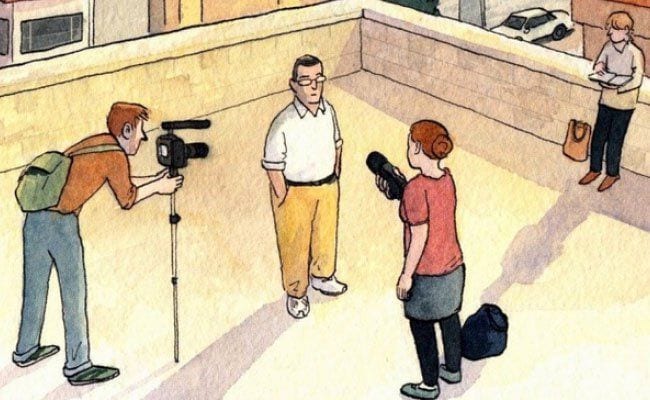
“There are rules to journalism that are common sense: do not deceive; work independently; minimize harm. But from there, lines start blurring. What is journalistic distance? Can it be measured? How much does it even matter? I’m beginning to see that so much of the practice of journalism comes down to questions that may be unanswerable.”
Sarah Glidden’s Rolling Blackouts: Dispatches from Turkey, Syria, and Iraq is part journalism and part travelogue. Following her friends, Sarah Stuteville and Alex Stonehill, independent journalists from Seattle’s online Globalist, and Stuteville’s childhood friend, Dan O’Brien, an Iraq War veteran, they take a reporting trip to the Middle East in 2010. Glidden is meant to observe and document their experience in comic form, while Stuteville and Stonehill mainly report on the many displaced persons from the Iraq War.
Glidden’s story is framed by transcriptions of conversations she witnessed and took part in, interspersed with her commentary. She makes great effort to be as accurate as possible in representing the trip and its evolving focus, and it’s because these moments are so honest that her insights after the fact work so well. Whether she comments on how excruciating it is to listen to herself try to contribute to a journalistic conversation, or she describes her feelings on Dan’s experience on the trip, Glidden is always relatable.
One of the book’s most intriguing and surprising arcs focuses on getting Dan to open up about how his experiences as a Marine in that area only a few years earlier colors the trip. Stuteville’s frustration with his reluctance to deviate from his own narrative — one he’d already expressed at the outset of the trip — and his constant awareness of being recorded speaks to the challenges of getting a subject to convey an honest account. Dan’s personal friendship with Stuteville and his perspective as a vet makes him wary of her questions and often puts the two at odds. It’s easy to sympathize with Stuteville’s exasperation, even as she acknowledges her own expectations for his story, but Dan’s unwillingness to be the perfect subject is also understandable. Glidden does an admirable job of presenting both sides.

Dan’s difficulty in communicating his experiences while also being hyperaware of being the subject of a story brings to the fore many journalistic questions for Stuteville. The ways in which she grapples with her own biases and expectations when it comes to interviewing Dan are especially illuminating, but it’s often in her conversations that she articulates these complications best. Glidden hasn’t only captured their trip from a purely reporting standpoint, but she’s also documented the process of reporting. It’s an approach that allows for an unexpectedly thoughtful examination.
One of Rolling Blackouts’ other arcs focuses on Sam Malkandi, an Iraqi refugee who had resettled in the United States with his family until he was arrested and eventually deported on immigration charges. His footnote connection to the “9/11 Commission Report” linked him to terrorism, though he maintains his innocence. Stuteville and Stonehill would even go on to make a documentary about Malkandi, Barzan, in 2013 (about Barzan Ibrahim al-Hasan al-Tikriti). Glidden does a wonderful job capturing the contradictions of Malkandi’s story and circumstances, particularly as she documents his attempts to stay connected to America through something as simple as snack foods, and the tragedies of his life in Iraq that led to his refugee status.
As a section of the book focuses on Syria, the current situation is highlighted in unanticipated ways. In 2010, refugees were seeking relief in Syria, and only a few short years later, the effects of the same war have turned Syria’s population into the one seeking refuge. It’s a striking consideration, one that helps to make Rolling Blackouts even more resonant.
Glidden’s art is of particular note, and not just because Rolling Blackouts is told in comic form. Her use of watercolors is beautifully rendered, creating a consistent visual language throughout the book that is a pleasure to look at, yet never distracts from the content of the story. In fact, in drawing real people she brings them to life in a way that humanizes and makes relatable circumstances. The watercolors also complement the narrative messiness of shifting borders and populations in ways that the precise hand of pen and ink would not.
Rolling Blackouts is about journalism and war, and the complexities of both. Truly independent reporting is often an impossible feat, still colored with personal feelings and experiences, regardless of the best intentions, and Glidden, in both writing and art, conveys that difficulty especially well.


![Call for Papers: All Things Reconsidered [MUSIC] May-August 2024](https://www.popmatters.com/wp-content/uploads/2024/04/all-things-reconsidered-call-music-may-2024-720x380.jpg)



